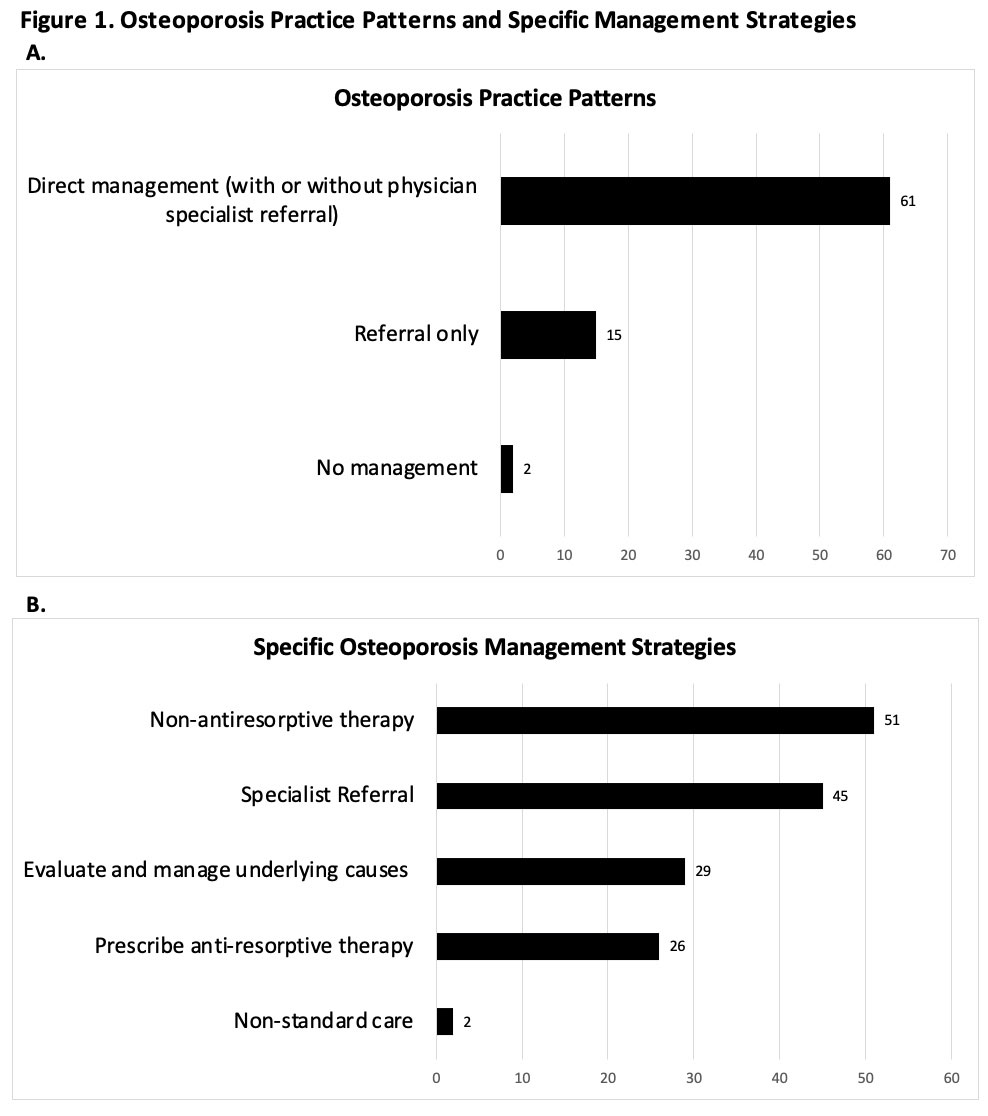Session Information
Session Type: Poster Session B
Session Time: 9:00AM-10:30AM
Background/Purpose: As they age, persons living with HIV (PLWH) are at increased risk for osteoporosis due to chronic infection and antiretroviral therapies (ART). In Peru, the physicians who provide ART are the primary point of medical care for PLWH, however there is no data on their management of osteoporosis and no national guidelines. To understand the osteoporosis management landscape, we studied self-reported comfort scores and practice patterns among HIV providers in partnership with Peru’s National HIV, STI and Hepatitis Program.
Methods: HIV providers working in the public sector with Peru’s National HIV, STI and Hepatitis Program were eligible to participate in this cross-sectional survey study. Physicians were identified via the Program’s provider registry, as well as by the Program’s Coordinators from 21/25 regions of Peru. Survey domains included: (1) sociodemographic characteristics (2) comfort level with osteoporosis prevention, diagnosis, and treatment (4-point Likert scale: no certainty, little certainty, certain, very certain), (3) osteoporosis-related screening patterns [use of the fracture risk assessment tool (FRAX) and dual-energy x-ray absorptiometry (DXA)], and (4) osteoporosis-related practice patterns, which was an open ended question later categorized as: “no management,” “physician specialist referral only,” and “direct management (with or without physician specialist referral).” Specific management strategies described were categorized as: “non-antiresorptive therapy” (vitamins, counseling, nutritionist, or physical therapist referral), “antiresorptive therapy,” “physician specialist referral,” “evaluate/modify underlying causes,” and “nonstandard care.”
Results: Of the 167 physicians identified during recruitment, 78 volunteers completed a telephone survey administered by a trained research assistant (mean age 45.8±9.3; 26% women; 61% were from coastal regions, 18% mountains, and 21% jungle). There were 61 Infectious Disease physicians and 17 Generalists/Internists seeing on average 105±116 HIV patients per month. Only 4% reported being very comfortable with osteoporosis-related prevention, diagnosis, and treatment, whereas the proportion of physicians with no or little comfort were 47%, 40%, and 52% in each domain respectively. The majority (91%) of physicians did not use the FRAX tool, and (73%) reported that ≤ 25% of patients who met age criteria were screened with DXA. However, 78% of physicians reported engaging in some degree of direct osteoporosis management, including counseling, evaluation of underlying causes, pharmacologic management, and referral for co-management.
Conclusion: This study provides a unique national perspective on existing osteoporosis management for PLWH in Peru. Although most surveyed physicians perform a degree of direct osteoporosis-related management, many report a low comfort level and few use screening tools. These findings highlight important areas for future physician support and training, as well as the necessity of practical osteoporosis guidelines that are applicable in resource-limited settings to support healthy aging in PLWH around the world.
Physicians were asked: “If you had a patient with osteoporosis, what actions would you take?” (1A) Histogram of osteoporosis-related practice patterns categorized from physician free responses to the question above. (1B) Histogram of specific management strategies categorized from physician free response to the question above. “Non-antiresorptive therapy” included diet and exercise counseling, vitamin prescriptions, nutrition and/or physical therapy referral. “Specialist Referral” included the following specialties: rheumatology, endocrinology, orthopedics, gynecology, geriatrics, internal medicine. “Evaluate and manage underlying causes” included reviewing or changing the ART regimen, evaluating diet, and/or ordering laboratory tests such as calcium and vitamin D. “Prescribe anti-resorptive therapy” included any anti-resorptive medication. “Non-standard care” included collagen pills or counseling weight loss.
To cite this abstract in AMA style:
Slotkin R, Granda Calderón C, Cabrera D, Benites Villafane C, Garcia P, Hsieh E. Comfort Levels and Practice Patterns for Osteoporosis-Related Care Among Persons Living with HIV in Peru: A National Physician Survey [abstract]. Arthritis Rheumatol. 2022; 74 (suppl 9). https://acrabstracts.org/abstract/comfort-levels-and-practice-patterns-for-osteoporosis-related-care-among-persons-living-with-hiv-in-peru-a-national-physician-survey/. Accessed .« Back to ACR Convergence 2022
ACR Meeting Abstracts - https://acrabstracts.org/abstract/comfort-levels-and-practice-patterns-for-osteoporosis-related-care-among-persons-living-with-hiv-in-peru-a-national-physician-survey/

